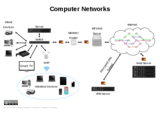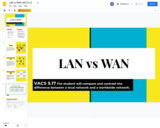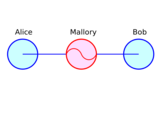
This is a slide show is intended to introduce students to networks, LAN, WAN, and WWW.
- Subject:
- Networking and the Internet
- Material Type:
- Activity/Lab
- Author:
- Jude Raffeinner
- Date Added:
- 12/30/2021

This is a slide show is intended to introduce students to networks, LAN, WAN, and WWW.

A Quizlet study set of 15 Computer Network terms and definitions. This is a study set with terms and definitions done on quizlet. It covers basic terms, as well as topogolies, and Ethernet cable types.This set can be used as reinforcement of these topics or as a short quiz to test understanding.

This Slide Presentation introduces IPv4 and IPv6 Addresses, what they are and why they are used. It discusses why we have two different versions in use.

These slide help to decipher between and explain Local Area Networks and Wide Are Networks. The teacher can use the slides to explain and then print the slides with pictures to display in the room as a reminder.

This is an unplugged version of how a man in the middle attack can happen and how data can be altered using rope, binder clips, envelopes and index cards.

Use the Google Jamboard to compare and contrast features of Local Access Networks and Wide Area Networks.

This is a slide presentation and reinforcing paper/pencil activity designed to introduce students to:NetworkLANWANInternet